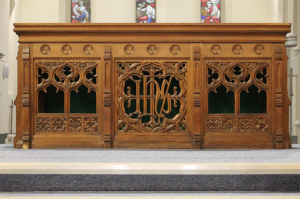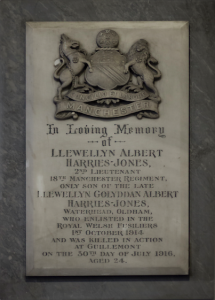None of the current church furnishings are original in consequence of three major phases of reordering, in 1883–1894, 1903–1906 and 2012–2014.
The Altar
The altar At Waterhead, the altar (or ‘communion table’) is of carved oak. The intricate moulding is of outstanding quality and accommodates a central IHS motif. The altar was introduced in 1906 at the same time as the east-end reredos, which is complementary in design and style. An inscription on the reredos reads, ‘To the glory of God and in loving memory of his dear sister Mary Leach who died 1st November 1905 this Reredos is erected by her affectionate Brother J. W. Leach.’
Until the slight reordering of 2008, the altar was positioned in the sanctuary directly in front of the reredos, thereby demonstrating the complementarity of fabric, ornament and style. The altar now resides at the front of the chancel.
The IHS symbol
After images of the cross, the most-common symbol seen in a Christian Church comprises the three letters IHS. The symbol represents the three consonants of the name ‘Jesus,’ when written in Latin. The IHS symbol is therefore intended to bring Jesus to mind each time a Christian sees it. The IHS symbol is often drawn with a cross above and three nails beneath, and with rays as of the sun.
The Chancel
The chancel is the part of the church that separates the sanctuary — its holiest part — from the nave in which the majority of the congregation are seated. So everything that happened in the chancel was done as a means of helping the people get closer to God, in the spiritual sense. That is why the altar is located in the sanctuary, the Vicar or priest sits in the chancel, and the lectern and pulpit are both located on the step between the chancel and nave. Traditionally, the choir also sit in the chancel because they lead the singing, and singing the praises of God is an important way of becoming holy.
The chancel was re-fitted in 1884, with encaustic tiles along the edges of the two chancel steps and covering the floor of the central aisle. At the same time, the panelled ceiling was painted with highly-coloured patterns.
The original choir stalls were replaced with pitch-pine stalls in 1894, which were themselves removed in 2007 after part of the chancel ceiling collapsed following a series of lead thefts from the roof. The waterlogged ceiling panels fell on the choir pews, splintering some and damaging most of the remainder.
The Font
 The word font comes from a Latin word meaning ‘fount’ or ‘fountain’ so its use involves water. A font is used for Christian baptism (or ‘Christening’ — the two names are entirely synonymous). During a baptism service, the font bowl is filled with water, and the person being baptised is ceremonially sprinkled or washed to suggest the idea of washing because the service is a means toward spiritual cleanliness. Baptism is also regarded as the rite of Christian initiation, so a person is baptised when formally accepted as a Christian.
The word font comes from a Latin word meaning ‘fount’ or ‘fountain’ so its use involves water. A font is used for Christian baptism (or ‘Christening’ — the two names are entirely synonymous). During a baptism service, the font bowl is filled with water, and the person being baptised is ceremonially sprinkled or washed to suggest the idea of washing because the service is a means toward spiritual cleanliness. Baptism is also regarded as the rite of Christian initiation, so a person is baptised when formally accepted as a Christian.
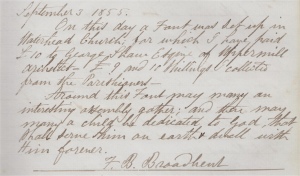
September 3 1855. On this day a font has been set up in Waterhead Church for which I have paid £10 to George Shaw Esquire of Uppermill, Architect – £9 and 10 shillings collected from the parishioners. Around this font may many an interesting assembly gather; and there may many a child be dedicated to God, that shall serve Him on earth and dwell with Him forever.
F.B. Broadbent
Waterhead Church originally had no font. Soon after its consecration, however, a small font was brought from ‘The Grove’ when it closed in 1847. Although small, it was used for all baptisms until 1855 — 336 in all.
But a new, larger font was needed. The current font was installed on Sunday 3 September 1855. Its bowl was carved to a simple yet elegant design from a single piece of Yorkshire stone.
There is no record of a font cover until 1903, when it acquired a dark and rather heavy cover, donated by local dignitary Elisha Bardsley JP. Its inscription read, ‘To the Glory of God, presented by Mr and Mrs Elisha Bardsley, in memory of their infant daughter, Mary Elizabeth Bardsley, June 1903.’
Elisha Bardsley
Elisha Bardsley was a prominent member of Oldham’s elite. By 1928, he had risen to become manager and salesman of the local Orb Mill. He was also involved in civic life.
He led the committee that erected the Waterhead War Memorial, on which his name appears on two separate faces. He was successively JP, Mayor of Oldham (1932–1933), and then Alderman. His magnificent tomb and family vault are located on the north side of the cemetery.
The font cover was removed during the reordering of 2012 and the font relocated from the south-west corner of the Church to a new and more accessible location. At the same time, a new, lighter cover was made. The font now resides at the front of the nave to one side of the chancel arch, on the stone base previously occupied by the last pulpit. The new location was chosen to maximise both visibility and audibility, and also enables family and friends who attend the service to sit.
The Lectern
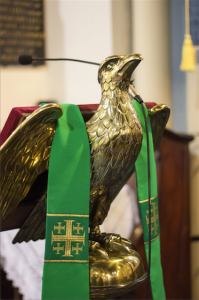 A lectern is a reading desk in a Church on which the Bible rests and from which the lessons are read during the church service. The lectern at Waterhead is of cast brass and, as is common elsewhere, resembles an eagle. The eagle is the traditional symbol of St John the Evangelist, because he was called ‘the Eagle of Patmos’ after the island on which he spent his last days before writing the Book of Revelation; and eagle because the eagle was thought to be the animal with the keenest sight in the entire animal kingdom. Just as the eagle could see further than any other of God’s creatures, so John’s spiritual eye saw God with a greater understanding and mastery than others. Furthermore, an eagle soars upwards, is strong and direct in its flight, and is inspiring in its over-arching majesty.
A lectern is a reading desk in a Church on which the Bible rests and from which the lessons are read during the church service. The lectern at Waterhead is of cast brass and, as is common elsewhere, resembles an eagle. The eagle is the traditional symbol of St John the Evangelist, because he was called ‘the Eagle of Patmos’ after the island on which he spent his last days before writing the Book of Revelation; and eagle because the eagle was thought to be the animal with the keenest sight in the entire animal kingdom. Just as the eagle could see further than any other of God’s creatures, so John’s spiritual eye saw God with a greater understanding and mastery than others. Furthermore, an eagle soars upwards, is strong and direct in its flight, and is inspiring in its over-arching majesty.
A year after arriving, the Church’s third Vicar Gouldie French started an appeal to raise the necessary funds to purchase a new lectern. It is not known why the previous, similar, lectern was not good enough. Messrs. Thomason and Sons of Manchester made Waterhead’s new lectern, which was paid for by public subscription. The most reliable source says it cost £35 2s 9½d. It was first used during the Church anniversary service on Sunday 4 July 1880.
The Nave
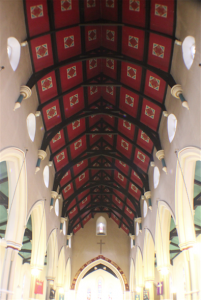
The nave: the glorious painted ceiling looking toward the chancel and sanctuary. The high chancel window was installed in 1934 to commemorate three members of the Lees family.
The main body of most Christian Churches is the nave. It provides the central approach to the altar and accommodation for the worshippers. Whatever the style of architecture, the nave generally extends from the point of entry through to the chancel and, in larger churches, is often flanked by lower side-aisles. The term nave comes from the medieval Latin navis (‘ship’), and may have been suggested by the keel-like shape of roof vaulting in early church architecture.
The nave at Waterhead is immensely high at nearly 80 feet at its apex, and is decorated with extravagant paintwork. The pews are of pitch pine. In 1883, Gouldie French renovated some pews and moved the rear-most third of them, so they were not separated by a wide passageway. Some of the pews were replaced in 1905, and the elegant ‘poppy heads’ were sawn off without permission in the mid-1960s.
The Organ

The south-east corner of the Church between 1876 (when the tower and spire were completed) and before 1905 when the organ chamber was completed. The position of the graves suggest a date in the 1890s.
Waterhead’s first musical accompaniment was a small chamber organ, reputedly from one John Smith of Greenacres. It was secondhand, cost £70, and had formerly done service in the Abbey Inn on West Street, Oldham. It was first used on 19 September 1856. It was later sold to the Revd Coghlan of St Andrew’s Church in Oldham, who removed it on 2 May 1873 and paid £25 for it.
Its replacement was a substantial organ made by Messrs Forster and Andrews of Hull. It was a 2-manual instrument (not 3 at that stage), and cost £460. As was common then, the organ was placed behind the congregation on the south side of the capacious west-end gallery. J Clapton of Oldham ‘opened’ the instrument on Whit Sunday, 1 June.

The Church organ, installed by Wadsworth of Manchester in 1905/6. It resides in a purpose-built organ chamber. It has three manuals.
Later, in 1905, the Church built a separate organ chamber beside the existing Church. It abuts the south side of the chancel in a style wholly in sympathy with Shellard’s original vision. At the same time, a wide aperture was opened between this new chamber and chancel to accommodate the organist and console. When ready, in 1905/6, Wadsworth of Manchester removed the organ from the west-end gallery and installed it into the new chamber. Wadsworth also added the third manual without any significant alterations to the original two. They cleaned and overhauled it again in 1926 and added an electric blower in 1930 (up until then it had been hand-blown).
A plaque on the organ front commemorates a renovation in 1963, but few details are known.
The Pulpit
Today, in common with a great many Churches, Holy Trinity has no pulpit, but it has had three during its long life.
Some sources suggest the first pulpit was a so-called triple-decker, erected to the immediate left of the chancel arch. No image remains of this triple-decker pulpit. The levels of the lecterns were intended to show the (then perceived) relative importance of their respective functions. The Revd P H Ditchfield wrote in the Waterhead Parish Magazine in 1920, ‘The pulpit used to have a habit of growing. At one time it grew into a ‘triple-decker’, a great monstrous place for the preachers; below that the reader’s desk; and lower still the clerk’s pew’. Members of the congregation in the Waterhead’s extensive balcony could sit almost at eye level with the preacher.

The second pulpit. The greenery may suggest Palm Sunday. The photo has been taken from the old (now removed) balcony.
Triple-decker pulpits were popular in the mid-to-late eighteenth century as they reflected a romanticised image of the past, but they were already being viewed as somewhat anachronistic when Waterhead’s was installed. Broadbent had the readings desk and pulpit ‘separated’ on 1 March 1869 to yield a more manageable place from which to preach. His first sermon from the second pulpit was on the verse, 1 Samuel 7:12 ‘Samuel took a stone and set it up between Mizpah and Shen. He named it Ebenezer, saying, “Thus far the LORD has helped us”.’
While no doubt adequate, this second pulpit was made of painted wood. Another pulpit was added in 1905 as part of the Church’s extensive programme of reordering. As was common for additions occurring at the end of this phase of Church architecture, this addition was of alabaster and marble (or possibly imitation marble). Unfortunately, being inferior stone, it discoloured badly over the years and had also become somewhat unsafe. It was removed in 2012.
The Pews
The nave contains two banks of pews. They are made of pitch pine, and have a box-pew design with individual doors. They were added in around 1901 (apparently the third attempt to provide seating). They were ‘modified’ without permission in the 1960s when the original carved ‘poppy’ ends were sawn off.
The Reredos
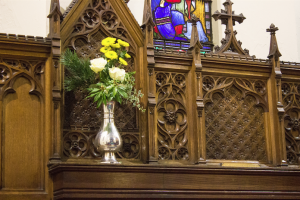 At the rear of the sanctuary, and along the eastern-most wall of the Church is a splendid reredos of traceried oak, which dates from the re-ordering of 1906. The central ‘shelf’ runs along the central third of the reredos at near head height and supports an ornate silver cross during services, and flower vases.
At the rear of the sanctuary, and along the eastern-most wall of the Church is a splendid reredos of traceried oak, which dates from the re-ordering of 1906. The central ‘shelf’ runs along the central third of the reredos at near head height and supports an ornate silver cross during services, and flower vases.
The Sanctuary
The sanctuary is usually regarded as the holiest part of a Church, so it is natural (within this mindset) to locate the altar within the sanctuary.
Until 2011, a simple altar rail of brass separated the sanctuary from the chancel.
At Waterhead, the sanctuary floor is a mosaic of differently coloured marble blocks. They form a pavement into which the coloured portions form the capital Greek letters alpha (A) and omega (Ω) on the left- and right-extremities of the altar plinth. The central image is the Star of David.
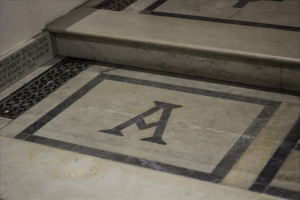 |
 |
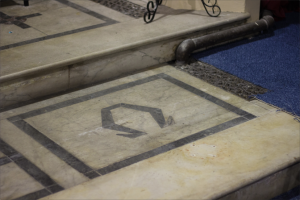 |
Alpha and Omega
The letters alpha (A) and omega (Ω) come from the Greek alphabet, and are that alphabet’s first and last letters. The very earliest Christians tended to combined A and Ω as an inter¬penetrating pattern (see right), to form a symbol.
Otherwise, the letters are positioned as a form of ‘bookends’ on either side of another symbol, for example at either end of a priest’s ornate scarf (or ‘stole’) or the two ends of the altar as here.In a Church, the letters A and Ω point toward Jesus who is described in the Bible (in its last book, Revelation 1:8 and 1:11) as ‘the first and the last, the alpha and the omega.’ In other words, Jesus’ presence and his power encompasses everything from start to finish.
Because these letters represent Jesus, the alpha and omega letters are usually represented as capital letters: current thinking says it would demean Jesus if we used lower-case letters (as α and ω) although many examples of early Christian art depict lower-case letters.
That the letters A and Ω section off the area around the altar indicates the preferred theology of the people who sponsored Waterhead Church. The role of an altar is to act as a focal point during Holy Communion. Some Christians think of Communion as a remembering of Jesus and the meal he had with his disciples on the night before his death. But at the time of Waterhead’s consecration in 1847, many Christians were looking back to the origins of the Church, remembering how Communion was then regarded as bread and wine actually becoming the body and blood of Jesus.
So, by writing A and Ω beside the altar, the builders of Waterhead church were making a visual statement: in their view, Jesus was somehow made especially present at the altar during Holy Communion.
The Bell
The current Church bell was made by the then famous Loughborough bell founders of J Taylor & Co., and cost £64 14s 0d including delivery and hanging.
![]() The bell was given by the first Vicar’s Warden, Thomas Green Brideoake. He had it inscribed ‘Thomas Brideoake gave me. 1876’. It was fixed in the tower on Saturday 23 December 1876, and rung for the first time the next day for a service of Evensong at which the preacher was the Lord Bishop of Manchester, the Rt Revd Dr Fraser. The collection at this service was an astonishing £35 13s 7d.
The bell was given by the first Vicar’s Warden, Thomas Green Brideoake. He had it inscribed ‘Thomas Brideoake gave me. 1876’. It was fixed in the tower on Saturday 23 December 1876, and rung for the first time the next day for a service of Evensong at which the preacher was the Lord Bishop of Manchester, the Rt Revd Dr Fraser. The collection at this service was an astonishing £35 13s 7d.
Church Memorials
Holy Trinity Church has relatively few memorials.
The Llewellyn Albert Harries-Jones memorial
Llewellyn was the only son of Golyddan Albert Harries-Jones (1863–1905) who is remembered in the lovely Harries-Jones window on the north side of the Church.
He joined the Royal Welsh Fusiliers on 1 October 1914 as a private but soon afterwards received a commission in the Manchester Regiment. He left the 27th Battalion of the Manchester Regiment in 15 July 1916 (then in Yorkshire) to join the 18th Battalion to fight on the Somme. Following the massacre of Trones Wood, the unit moved to the village of Guillemont, which was attacked on 20 July 1916. There were 484 casualties and only one of the 15 officers survived; Harries-Jones was reported missing and later confirmed killed in action. He was 24 years of age. Curiously, his name does not appear on the Church roll of honour.
The Joseph Mayall memorial
On 4 April 1918, HMS Bittern was involved in a collision in impenetrable fog with SS Kenilworth off the Isle of Portland in the English Channel. The destroyer sank almost immediately with the loss of all hands, including Joseph Mayall, the only son of Waterhead Church dignitary, John Mayall (himself son of Edward Mayall, the first Warden. The subsequent Court of Inquiry found negligence on the part of the master of SS Kenilworth.
